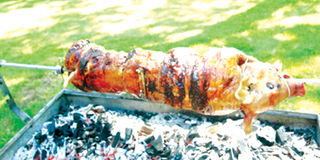Prime
How to make a roasted porker

What you need to know:
Describing the preparation of roast pig to her skilled Indian cook, she wound up with the announcement: ‘The pig is brought to table on plenty of greenery, with an apple in the mouth.’
In one of their cookbooks, the sisters Irma Rombauer and Marion Rombauer Becker regale us with a story about a sucking pig, one that may indeed be apocryphal, regardless that whenever I come across it I am thrown in stitches: “We never think of sucking pig without recalling our friend Amy, an American, long a resident of Mexico but determined to reconstruct in alien surroundings the traditional Christmas dinners of her youth. Describing the preparation of roast pig to her skilled Indian cook, she wound up with the announcement: ‘The pig is brought to table on plenty of greenery, with an apple in the mouth.’
“The cook looked first baffled, then resentful and finally burst out with a succession of ‘no’s.’ Her employer persisted patiently with helpful gestures and increasing firmness. When the pig was served she discovered that her cook could effect an entrée that surpassed her wildest expectations. There was plenty of greenery and a distinct air of martyrdom; but the apple was clenched, not in the pig’s mouth, but in that of the desperate cook!”
The first order of business would be to go out and find a suitable porker and for this we highly recommend the Nalukolongo abattoir based in the outskirts of Kampala, just off Masaka Road before you get to Nateete. However, be warned that the scene is grisly and borders on the barbarous so if you are squeamish about these things just contact Mr John Nagenda who will be happy to give you the finished product in the form of rigor mortis and oven ready.
We settled for a blackish 30 kilo or so porker, though I would recommend more like one that weighs no more than six kilos if you are doing it at home in a regular oven. In our case, we would be using the spit or rotisserie method that is ideal for a whole porker and other chunky meats. The next step is for the beast to be literally pulled by the ears and dragged along by a hunky and burly lad to the slaughter. Within a matter of minutes the throat is skillfully slit and it is all over in the blink of an eye. Moments later, she is bathed in boiling water while a team of lads armed with sharp razor blades shave the animal and remove all the fur and hair and finally the entrails are removed.
Did you know that in France the Chitterlings or the intestines form the base for the famous Andouillette sausage? In this case, after slaughtering, the intestines are collected while still warm and then turned inside. At the same time, the mucous membrane is completely scrapped out. They are then soaked in salted water and refrigerated overnight. To serve, they are washed several times and then cut into small sizes and boiled with herbs, salt, pepper etc. They go well with black peas and corn bread.
Finally, the porker undergoes several washes and then the most important part is the inspection of the liver by the veterinary doctor. Any traces of illness such as trichinosis would be detected and the pig would be deemed not fit for human consumption.
Ingredients:
- A dressed five to six kilo whole porker intact with head and tail
- Olive oil
- Flour
- An apple
- Raisins
- Various assorted greens such as spinach, kale, dodo, bugga etc.
- Aluminum foil
For the stuffing:
- 1.5 kilos of sautéed sausages
- 1/2 cup dry breadcrumbs (made from fresh dry bread)
- 4 chopped onions
- 4 cloves crushed garlic
- 2-3 stems of celery chopped but minus the leaves
- 1/2w tsp mixed herbs (optional)
- Pepper to taste
- A bit of milk
- Whole garlic
Method
1. Combine the ingredients for the dressing and moisten them with a bit of the milk. Taste and correct seasoning, truss the pig with some kitchen twine and put a block of wood in the mouth or an Irish potato. Tie the front legs together and pull backward. Next, tie the hind legs together and bring forward, the pig should now be in a crouching position. Then, tie all four legs together.
2. Remove the eyeballs, lower the lid and rub the pig with the olive oil until it has a nice sheen to it; rub as much garlic into the skin as you wish. Cover the ears and tail with aluminum foil and have ready an oblong dish where it will comfortably fit.
3. Insert a meat thermometer towards the top of the hip muscles and allow 40 minutes for each kilo at 350 d FH or 177 d Celsius while basting every 15 minutes. The internal temperature should reach 165 d FH to 170 d FH.
4. When ready to serve, let it rest at room temperature for a half hour and remove the foil from the ears and tail. Place it on a platter and remove the wood from the snout, replacing with a small apple.
5. Drape around the neck a wreath of parsley and surround the platter with plenty of boiled greens. Get hold of some raisins and place them in the eyes. In case you have cranberries, they do just as well.
6. If you are really quite active, go ahead and surround the pig with a bounty of stuffed tomatoes, green pepper and apples.
7. Serve with pan gravy and make sure that each person gets some of the delicious crackling skin.




